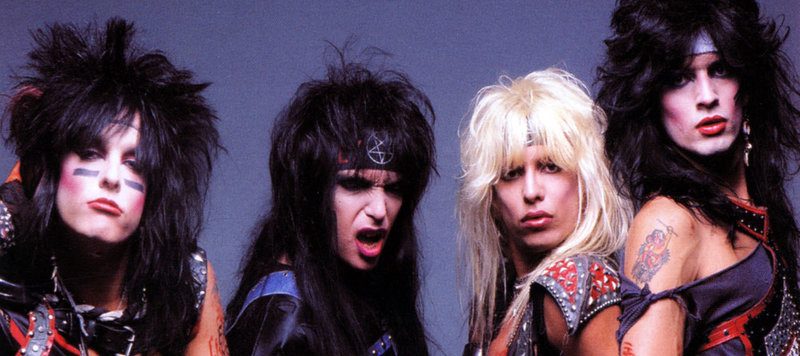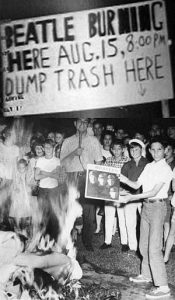The inside of the liner of Shout at the Devil contains a simple warning message: this record may contain backward messages. While a seemingly harmless warning, the simple technique of backwards masking (back-masking), or playing a portion of a musical or lyrical phrase in reverse, was at the center of Satanic accusations especially in earlier rock.

Thomas Edison with the gramophone. He was the first person credited with being able to capture sound and play it back.
The origin of backwards masking is a fairly innocuous one. The technique was discovered in 1878 with Thomas Edison’s invention of the phonograph. Edison noted that the cylinder of the device could be rotated backwards to create a pleasing sound effect, stating that, “the song is still melodious in many cases, and some of the strains are sweet and novel, but altogether different from the song reproduced in the right way (Macdonald).”
The technique was later acquired by popular musicians, where audio sources were frequently reproduced in reverse as part of a passage in a musical piece. This effect was typically achieved by recording an audio source onto magnetic tape and then playing the tape backwards on a special recorder (Green). The Beatles in particular are credited to have first stumbled across back-masking while making their album Rubber Soul in 1965, where they featured a back-masked line in “Rain,” a single released in 1966. The reversed vocal is the first line of the song played during the fade-out. “On the end of Rain you hear me singing it backwards,” John Lennon told Rolling Stone magazine in 1968. “We’d done the main thing at EMI and the habit was then to take the songs home and see what you thought a little extra gimmick or what the guitar piece would be. So I got home about five in the morning, stoned out of my head, I staggered up to my tape recorder and I put it on, but it came out backwards, and I was in a trance in the earphones, what is it – what is it? It’s too much, you know, and I really wanted the whole song backwards almost, and that was it. So we tagged it on the end (Macdonald).” The technique still exists to this day, particularly in Hip Hop where it is more commonly known as scratching.
 With such innocent origins and prevailing use, it begs the question of how back-masking became tied to Satanism. Earlier, in the 1920s, another individual who cited playing records backwards as a useful tool was Aleister Crowley, an infamous magician and theatrical occultist said to have inspired modern Satanism. He bought the technique to public attention when he praised his students who wished to become highly skilled in the art of the occult to learn and “do many things backwards”, including listening to phonograph records backwards (Phoenix). This then attached very negative connotations towards satanic rituals.
With such innocent origins and prevailing use, it begs the question of how back-masking became tied to Satanism. Earlier, in the 1920s, another individual who cited playing records backwards as a useful tool was Aleister Crowley, an infamous magician and theatrical occultist said to have inspired modern Satanism. He bought the technique to public attention when he praised his students who wished to become highly skilled in the art of the occult to learn and “do many things backwards”, including listening to phonograph records backwards (Phoenix). This then attached very negative connotations towards satanic rituals.
The artists who used the techniques later on were not spared from this connotation. The Beatles, for instance, were involved in the spread of back-masking not only as a recording technique, but also as the center of controversy. In 1969, DJ Russ Gibb received a phone call from a student at Eastern Michigan University. The caller asked Gibb about a rumor that Paul McCartney had died, claiming that the Beatles song “Revolution 9” contained a backward message confirming the rumor. Gibb played the song backwards on his turntable, and heard “Turn me on, dead man … turn me on, dead man … turn me on, dead man …”. Gibb began telling his listeners about what he called “The Great Cover-up (Sullivan).”
The “Paul is dead” rumor popularized the idea of back-masking in popular music. After Gibb’s show, many more songs were found to contain phrases that sounded like known spoken languages when reversed. Initially, the search was done mostly by fans of rock music, but in the late 1970s, along with the rise of the Evangelical movement, fundamentalist Christian groups began to claim that back-masked messages could be used for subliminal messaging, where ideas and messages would be unknowingly accepted by the listener.
In 1981, Christian DJ Michael Mills began stating on Christian radio programs that Led Zeppelin’s “Stairway to Heaven” contained hidden Satanic messages that were heard by the unconscious. Allegations of demonic back-masking were also made by social psychologists, parents and critics of rock music, as well as the Parents Music Resource Center (formed in 1985), which accused Led Zeppelin of using back-masking to promote Satanism (Macdonald).

